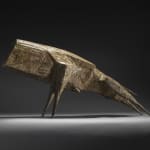 Lynn Chadwick
Maquette for Lion
Lynn Chadwick
Maquette for Lion1961, Bronze
Edition of 4
 Dying Lioness in Ashurbanipal relief at the British Museum © Carole Raddato
Dying Lioness in Ashurbanipal relief at the British Museum © Carole Raddato
 Above: Dying Lioness in Ashurbanipal relief at the British Museum © Carole Raddato
Above: Dying Lioness in Ashurbanipal relief at the British Museum © Carole Raddato
Below: Lynn Chadwick Maquette for Lion, 1961, Bronze, Edition of 4
Lynn Chadwick grew up in a modest double fronted house on Station Road in Barnes. His father was a successful engineer and later local mayor and his mother was a keen, if conservative, follower of culture. Weekends as a child were spent visiting museums and and galleries, as well as theatres and Kew Gardens with his sister Margery.
We know that Chadwick particularly enjoyed visiting the British Museum and he has described how the energy he saw in the Easter Island head there was something he hoped to achieve in his own work. He believed that not predicting or designing the work in advance meant this might be more possible, channelling an energy from his subconscious.
Chadwick must have seen at the British Museum this large and powerful image of a dying lioness pierced with arrows. It is an Assyrian relief that once adorned the walls of the royal palace of King Ashurbanipal in 7th Century BC in Nineveh, Mesopotamia.
He may also have been subliminally inspired by the sculptor Jacob Epstein (1880–1959) whose controversial Rima Chadwick recalls going to see in Hyde Park as a boy to ‘see the horrors of Modern Art’. He also visited Epstein’s Memorial to Oscar Wilde, 1914 whilst in Paris in 1932 and both works can be considered to have a certain Assyrian aesthetic.



